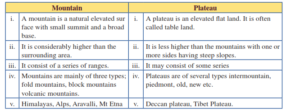There are an endless number of landforms on the planet. The four major types of landforms are mountains, hills, plateaus, and plains. Any natural elevation of the earth’s surface is referred to as a mountain. Fold Mountains, Block Mountains, and Volcanic Mountains are the three types of mountains. A plateau is a flat-topped table terrain that rises above its surroundings. Large swaths of flat land are known as plains. Students who desire to excel in their studies and ace their final exam can use the NCERT Solutions for Class 6 Social Science Geography Chapter 6 provided by INFINITY Learn.
NCERT Solutions for Class 6 Social Science – The Earth Our Habitat Chapter 6 Major Landforms of the Earth
TEXTUAL QUESTIONS
Ques 1. What are the major landforms?
Ans. The major landforms are:
i) Mountains ii) Plateaus iii) Plains
Ques 2. What are the different types of mountains?
Ans. The different types of mountains are:
i) Fold Mountains ii) Block Mountains iii) Volcanic Mountains
Ques 3. How are plains formed?
- Most of the plains are formed by rivers and their tributaries.
- The rivers flow down the slopes of mountains and erode them.
- They carry forward the eroded material. Then they deposit their load (consisting of stones, sand, and silt) along with their courses and in their valleys.
- From these deposits, the plains are formed.
Ques 4. What is the difference between a mountain and a plateau?

Ques 5. How are mountains useful to man?
Ans. Mountains are useful to man in the following ways:
- They are storehouses of water.
- They provide water to rivers through glaciers.
- Reservoirs are made and water is harnessed for the use of people.
- Water from mountains is used in irrigation and the generation of hydroelectricity.
- River valleys and river terraces are ideal for agriculture.
- Mountains have rich variety of flora and fauna.
- Forests provide fuel, fodder, shelter, fruits, herbs and other products.
- Mountains provide ideal sites for tourists.
- They are important sites for several special sports like paragliding, hang gliding, rafting, and skiing at Kullu, Manali, Shimla, Dharmashala, Dehradun.
Ques 6. “The river plains thickly populated” Give reason.
Ans. River plains are thickly populated because of the following reasons:
- Plains are fertile lands that support good agriculture. So plains are thickly populated.
- Means of transport are easy. Construction of roads and railway lines are easy.
- Ideal for human habitation due to flat land.
Ques 7. Why are mountains thinly populated?
- Mountains are thinly populated because they have steep slopes and lack good soil.
- These soils are not suitable for agriculture.
- Harsh climate.
- Less land available for farming.
- Very few employment opportunities
- Less developed means of transport.

Tick the correct answers.
(a) The mountains differ from the hills in terms of
(i) elevation (ii) slope (iii) aspect
(b) Glaciers are found in
(i) the mountains (ii) the plains (iii) the plateaus
(c) The Deccan Plateau is located in
(i) Kenya (ii) Australia (iii) India
(d) The river Yangtze flows in
(i) South America (ii) Australia (iii) China
(e) An important mountain range of Europe is
(i) the Andes (ii) the Alps (iii) the Rockies
Fill in the blanks.
- A ___________ is an unbroken flat or a low-level land. plain
- The Himalayas and the Alps are examples of _______________types of mountains. young fold
- _____________ areas are rich in mineral deposits. Plateau
- The _________________ is a line of mountains. range
- The ____________areas are most productive for farming. plain
The NCERT Class 6 Social Science Geography Chapter 6 Major Landforms of the Earth explains that the earth’s surface is unique in every location. Landforms are natural physical features of the planet that include mountains, plains, glaciers, valleys, and plateaus, and are discussed in this chapter.
The earth’s landforms are the product of two conflicting processes: exterior and internal activities. External processes such as flowing waves, wind, and ice, as well as running water, have a slow effect on the earth’s surface. Internal processes such as earthquakes and volcanic eruptions work within the earth’s surface, causing upliftment of the surface and the development of plateaus and mountains.
The numerous types of mountains that fold, volcanic, and block mountains, as well as the purposes of mountains on the earth’s surface, are explained in CBSE Class 6 Geography Chapter 6, Major Landforms of the Earth. It also describes how plateaus are used and how important plains are. All of these themes are thoroughly covered in Chapter 6 of the Geography textbook for Class 6.
Students seeking information on key landforms, such as how and why they occur, as well as the various types of landforms. The solutions to these questions may be found in the NCERT Solutions for Class 6 Geography Chapter 6 pdf accessible below, which includes information on how and why plateaus and mountains are produced, as well as information on glaciers, plains, and rivers. All of the questions covered have succinct and well-explained responses in the pdf.
INFINITY Learn’s solutions are written by subject experts, so you don’t have to worry about their accuracy. With a click of the mouse button on the pdf link provided below, you may download NCERT Solutions Class 6 Social Science – The Earth Our Habitat and simplify your preparation.
How Does INFINITY Learn Help you Score Good Marks in Board Exams?
Is critical to use appropriate study materials in order to achieve good results in any examination. You will not be able to perform well on the exam if you do not have the appropriate study materials. INFINITY Learn will assist you in achieving a high exam result. INFINITY Learn is the greatest site for exam preparation because it offers comprehensive study materials. Our knowledgeable team members have prepared all of the study materials. INFINITY Learn has also provided you with the answers to all past years’ questions. These questions will help you understand how the questions in the exam might be asked. INFINITY Learn provides reference materials that might assist you in improving your performance and achieving good test results.
FAQs
- What are some of the key points covered in Chapter 6 of NCERT Solutions for Class 6 Geography?
- From Chapter 6 of NCERT Solutions for Class 6 Geography, explain how mountains are valuable to man.
- What are the main takeaways from utilizing the NCERT Solutions for Geography Chapter 6 in Class 6?
1. What are some of the key points covered in Chapter 6 of NCERT Solutions for Class 6 Geography?
Students will learn about the many landforms that the Earth has in chapter 6 of NCERT Solutions for Class 6 Geography.
This chapter covers the following crucial topics:
- Mountains
- Plateaus
- Plains
Students can use the NCERT Solutions supplied by INFINITY Learn for free to study these topics in depth.
2. From Chapter 6 of NCERT Solutions for Class 6 Geography, explain how mountains are valuable to man.
Mountains are beneficial to man in a variety of ways, which are stated below:
- Mountains are water reservoirs.
- Forests supply fuel, feed, shelter, and other items such as gum and raisins, among other things.
- Mountains are home to a diverse range of vegetation and fauna.
- Crop cultivation is ideal in the river valleys and terraces.
- Mountain water is also used for cultivation and hydroelectric power generation.
- Mountain sports such as paragliding, hang gliding, river rafting, and skiing are popular.
3. What are the main takeaways from utilizing the NCERT Solutions for Geography Chapter 6 in Class 6?
The following are the main takeaways from utilizing the NCERT Solutions for Class 6 Geography Chapter 6:
- The solutions include all of the major concepts to help students obtain a thorough comprehension and knowledge.
- Subject matter experts have handpicked the solutions to provide students with a simple and useful study guide.
- A wonderful time-saver for students looking for the correct solutions to textbook questions and an outstanding revision resource.
- Students can download the solutions in PDF format for free, depending on their needs.



